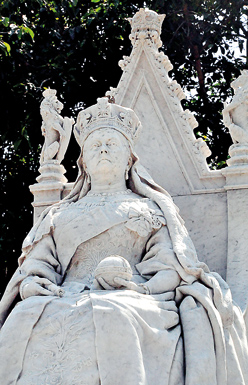Victorious Victoria
Victoriana abounds in Colombo, perhaps to a greater degree that it does in many other Commonwealth capitals. Remainders and reminders of England’s monarch with the puffed-out cheeks appear at every turn. She is present in sturdy respected institutions, secular and sacred. Consider the boys’ school Royal College, founded in 1835; the Anglican St Paul’s Church Milagiriya, Bambalapitiya, consecrated in 1854; the Colombo National Museum, opened in 1877, and the Victoria Memorial Eye Hospital, with its mustard-ketchup façade, at de Soysa Circus, built in 1903.

Part of Colombo’s history: The statue of Queen Victoria
Victoria is present in the bones of the city, its roads and railways and extant 19th-century structures. She is built into the urban infrastructure. Colombo is a profoundly Victorian capital.
Queen Victoria is also in our psyche. We grew up surrounded by Victoriana, at home, at school. Born in the 1880s and ‘90s, our grand-parents, grand-aunts and grand uncles were Victorian. They preserved and represented a Victorian correctitude that shaped our upbringing. We played hide-and-seek among Victorian-walauwe furniture and artefacts, and read Victorian books like “Alice in Wonderland” and Edward Lear’s “Book of Nonsense”, and later Dickens and Thackeray and Trollope.
We had a children’s annual with a portfolio of black-and-white photographs of Queen Victoria and her family. A favourite image showed an elderly, grand-aunt-like Victoria penning a letter at an ornamental writing desk, much like those we had seen in the homes of grand-aunts and uncles.
Queen Victoria is the most approachable, maternal-looking of any monarch we have seen in history books. As children, we felt she was someone you would want to go up to and talk to, and expect to be given a stick of liquorice allsorts. As children, our minds and sensibilities did acquire a kind of Victorian tint and tilt, suggestive of daguerreotypes and long mirrors with heavily ornamented frames.
Queen Victoria (1837-1901) is also there in person, in Colombo, in the magnificent marble statue that now sits at the National Museum gate facing Nelum Pokuna Mawatha. She has been spruced up for this week’s big Commonwealth summit. She sits on her throne and gazes into the thickets of a park that was originally named after her.
We remember Queen Victoria when her statue sat in leafy richness in the garden of Queen’s House, Colombo 1. Her marble white presence looked like a daylight ghost among the greenery. The back of her throne and her plump-cheeked profile was visible from the upper deck of the red double-decker buses. She was nearest and most clearly visible in the moment the bus swung from Queen’s Street into Prince Street. That was as close as we got to Queen Victoria the Statue.
Older Brother was luckier. In the late ‘50s, he and a gang of privileged classmates got to run around the garden of Queen’s House. The 10-year-olds were guests of Mohan Dodanwela, grandson of Sir Oliver Ernest Gunatilleke, who was Governor-General at the time. Saturdays in the early Sixties were spent in the garden of Queen’s House, playing cowboys-and-Red Indians at Queen Victoria’s feet, and inside Queen’s House, playing hide-and-seek around a sofa graced by Queen Elizabeth, who visited in 1954. Younger Brother was also lucky. He and his classmates were introduced to Queen Victoria the Statue during a school outing in the ‘60s.
It is nice to have easy access to the Queen Victoria statue. She is, after all, a solid and substantial part of the Commonwealth story. She was banished from the garden of Queen’s House and sent to the National Museum some years ago, when a more recent occupant of the grand house, now President’s House, feared bad luck from her presence.
Colombo’s Queen Victoria has been comparatively well treated. Her bronze equivalent in Hong Kong underwent far worse humiliations. During the Japanese Occupation, in 1942, her statue, along with other bronze monuments set up in Hong Kong’s Statue Square, were shipped to Japan to be melted down, to be saved just in time, and sent back, when the Pacific War ended.
Hong Kong’s bronze Queen Victoria sits in Victoria Park, which is cooled by the breezes blowing off Victoria Harbour. Our weekends in Hong Kong often included a walk past or around the bronze Victoria, whenever we came into town to shop and dine in Causeway Bay or visit the Hong Kong Central Library, which faces the Queen, from across Causeway Road.
The bronze Victoria’s second public humiliation took place in September 1996, when an artist from Mainland China climbed a ladder and emptied cans of red paint on Victoria’s head and smashed her nose in with a hammer. The artist said he was acting in the name of Art. The police called it vandalism and arrested the artist. Cultural commentators said the display of red and assault on a foreign cultural artefact was typical of mob behaviour during Chairman Mao Tse-tung’s Cultural Revolution of ’67-’77.
In the house opposite our grandparents’ home in School Lane, Colombo 3 lived for many years a very Queen Victoria-like personage. She had the plumped out cheeks of Victoria, her eyes were large, and her demeanour was that of a matriarch. She had a strong, maternal presence. She was Olive Ratnayake, nee Weerasinghe, wife of Victor Ratnayake of Deniyaya. She had most of her life presided over a walauwe, and when she settled in Colombo, she retained the walauwa lady persona. Whenever we saw her, which was almost daily for a couple of decades, we were reminded of the monarch.
Now, that her statue, in all its monumental tonnage, has been set down in the heart of the city, Queen Victoria is unavoidable, almost unbudgeable. Like it or not, like her or not, she’s here to stay.



